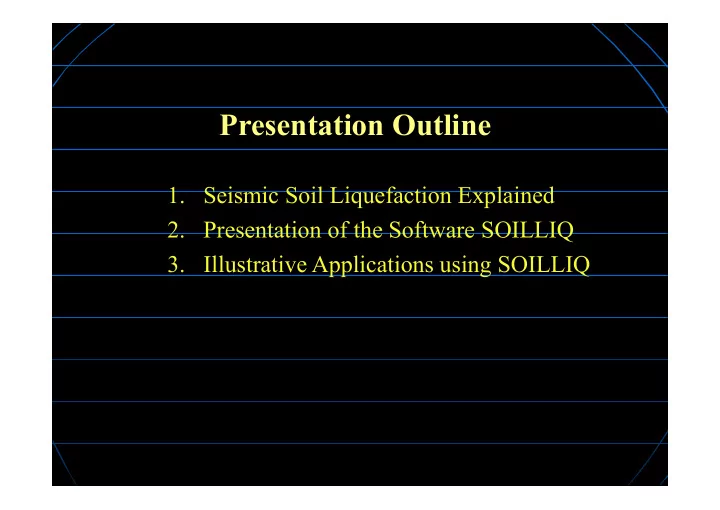

Presentation Outline 1. Seismic Soil Liquefaction Explained 2. Presentation of the Software SOILLIQ 3. Illustrative Applications using SOILLIQ
Foundation Failures in Residential Buildings (1964 Niigata, Japan Earthquake)
What Is Soil Liquefaction? • During dynamic loading (as in the case of an earthquake) strength and stiffness of soil can be significantly reduced • Eventually the soil begins to behave like a liquid rather than solid (liquefaction). • Liquefaction typically occurs in saturated loose sands, which tend to contract in volume under dynamic loading. • Earthquake shaking can cause the pore pressure, which is initially low, increase to the point where the soil particles can readily move with respect to each other (zero effective stress case). σ′ = σ – u => τ = c' + σ' tan φ'
Typical Soil Liquefaction during Dynamic Loading Tests on Saturated Sand (Ishihara, 1996)
Soil Liquefaction Related Phenomena Sand boils on the ground surface (solid evidence of liquefaction occurrence) Ground settlement Lateral spreading of slopes Ground oscillations (waving motion of the ground) Slope failures Damage in various forms on structures Soil liquefaction related phenomena have been responsible for tremendous amounts of damage in historical earthquakes around the world.
Associated Adverse Effects on Structures Bearing capacity loss of foundations Distress (and hence damage) to superstructure due to differential settlements Increased pressures on retaining walls Floating of buried objects (like pipes and tanks)
Soil Skeleton during Liquefaction
Effects of Liquefaction on Surface Structures
Regions of man-made landfill fared poorly in the 1906 San Francisco where damage from the 1906 earthquake was associated with liquefaction and ground failure (adopted from web)
Many regions of man-made landfill liquefied in the 1989 Loma Prieta earthquake. The Marina district, a shallow bay filled in after the 1906 earthquake, suffered some of the worst damage in the 1989 earthquake (USGS photo)
Increased water pressure can also trigger landslides and cause the collapse of dams. Lower San Fernando dam suffered an underwater slide during the San Fernando earthquake, 1971 (adopted from web)
Liquefaction induced damages after 1964 Alaska Earthquake in Anchorage.
Liquefaction induced damages after 1995 Hyogo-Ken Nanbu Earthquake at Kobe (Japan).
Vehicles stuck in liquefaction sink holes during 2011 Christchurch Earthquake in New Zealand
Foundation Bearing Failures (Adapazari, Turkey, 17 August 1999 Izmit Earthquake )
Foundation Bearing Failures (Adapazari, Turkey, 17 August 1999 Izmit Earthquake)
Foundation Bearing Failures (Adapazari, Turkey, 17 August 1999 Izmit Earthquake)
Liquefaction Induced Excessive Settlement of a Hotel Building (Southwest of Adapazari)
Liquefaction Induced Lateral Spreading (North of Van)
Sand Boilings (North of Van)
Factors Governing Liquefaction Earthquake intensity and duration Presence of groundwater Soil type Relative density Particle size gradation In-situ confining pressures Aging and cementation (binding of particles)
Assessment of Liquefaction Triggering 1. Through correlations with field penetration testing (based on the simplified method proposed by Seed et al., 1975) 2. Laboratory testing based methods
Field Penetration Testing Approach Factor of safety against liquefaction: FS = CRR / CSR CRR (Cyclic Resistance Ratio): Represents resistance of the soil against liquefaction based on SPT CSR (Cyclic Stress Ratio): Represents liquefaction demand imposed by earthquake (CSR = τ cyc / σ′ v0 )
Relationship between CRR and SPT-(N1) 60 (Seed et al., 1975)
CSR = τ cyc / σ′ v0
Corrections to SPT (adapted from Youd et al., 2001) Factor Equipment variable Term Correction (P a / s ' vo ) 0.5 , C N ≤1.7 Overburden pressure - C N Hammer efficiency Donut Hammer E m 0.4-0.6 Hammer efficiency Safety Hammer E m 0.4-0.7 Hammer efficiency Automatic trip Donut Hammer E m 0.5-0.85 Rod length < 3m n 1 0.75 Rod length 3-4 m n 1 0.80 Rod length 4-6 m n 1 0.85 Rod length 6-10 m n 1 0.95 Rod length 10-30 m n 1 1 Sampler Correction Without liner n 2 1 Sampler Correction With liner: dense sand, clay n 2 0.8 Sampler Correction With liner: loose sand n 2 0.9 Borehole diameter 65-115 mm n 3 1 Borehole diameter 150 mm n 3 1.05 Borehole diameter 200 mm n 3 1.15 N C E n n n field N m 1 2 3 N 60 0 . 60
Corrections to SPT (continued) N 60 = N field C N E M N 1 N 2 N 3 / 0.60 where N field = measured standard penetration resistance C N = factor to normalize N field to a common reference effective overburden stress of 1 Atmosphere (100 kPa) E M = hammer efficiency n1 = correction factor for rod length n2 = correction factor for samplers n3 = correction factor for borehole diameter.
Corrections to SPT (continued) Another important factor is the energy delivered from the falling hammer to the SPT sampler. Hammer efficiency of 60% is accepted as a reference value for energy corrections. The energy ratio delivered to the sampler depends on the type of hammer, anvil, lifting mechanism, and the method of hammer release. Approximate hammer efficiencies for various types of hammers and anvils vary between 0.40 and 0.85. The corrections suggested for rod length, sampler and borehole diameter are also indicated in the table .
(N 60 ) cs : İnce malzeme oranı düzeltmesinden sonraki SPT darbe sayısı a , b : ince malzeme oranı düzeltme katsayıları FC: İnce malzeme oranı
(N 60 ) cs <30 ise zemin sıvılaşma değerlendirilmesine tabi tutulur. (N 60 ) cs ≥30 olan zeminlerin sıvılaşmayacağı kabul edilir . MSF: Deprem magnitüdü düzeltme faktörü M w : Deprem magnitüdü
Sıvılaşma Durumunda Zemin Parametrelerine uygulanacak Azaltma Faktörleri FS Zemin Azaltma yüzeyinden Faktörü, D derinlik (m) FS≤0.6 0≤x≤10 0 10≤x≤20 1/3 0.6<FS≤ 0.8 0≤x≤10 1/3 10≤x≤20 2/3 0.8<FS≤ 1.0 0≤x≤10 2/3 10≤x≤20 1
Sıvılaşmadan sonra meydana gelecek oturmalar Tokimatsu ve Seed (1984) tarafından önerilen hacimsel birim deformasyon ilişkileri
Ishihara ve Yoshimine (1992) tarafından önerilen hacimsel birim deformasyon ilişkileri
s: Sıvılaşmadan sonra beklenen oturma miktarı t: İlgili tabaka kalınlığı
Recommend
More recommend